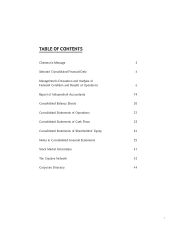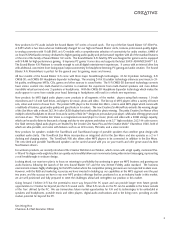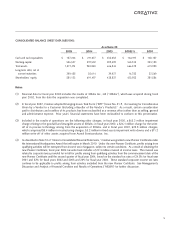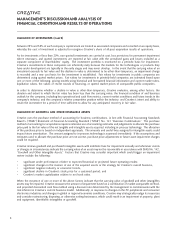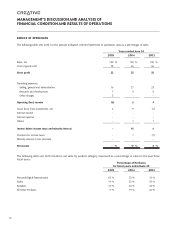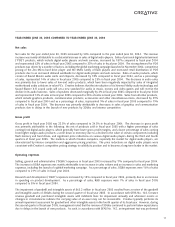Creative 2005 Annual Report Download - page 7
Download and view the complete annual report
Please find page 7 of the 2005 Creative annual report below. You can navigate through the pages in the report by either clicking on the pages listed below, or by using the keyword search tool below to find specific information within the annual report.
7
REVENUE RECOGNITION
Revenue from product sales is recognised when persuasive evidence of an arrangement exists, title and risk of loss have been
transferred, delivery has occurred, the price is fixed or determinable, and collection is probable. Allowances are provided
for estimated returns, discounts and warranties. Management analyzes historical returns, current economic trends and
changes in customer demand and acceptance of its products when evaluating the adequacy of the sales returns allowance.
Such allowances are adjusted periodically to reflect actual and anticipated experience. When recognizing revenue, Creative
records estimated reductions to revenue for customer and distributor programs and incentive offerings, including price
protection, promotions, other volume-based incentives and rebates. Significant management judgement and estimates must
be used in connection with establishing these allowances in any accounting period. Creative may take action when necessary
in response to market conditions to increase customer incentive offerings, possibly resulting in an incremental reduction of
revenue at the time the incentive is offered.
ALLOWANCES FOR DOUBTFUL ACCOUNTS, RETURNS AND DISCOUNTS
Creative distributes its products primarily through third party resellers. Creative establishes allowances for doubtful accounts,
returns and discounts for specifically identified doubtful accounts, returns and discounts based on credit profiles of its
customers, current economic trends, contractual terms and conditions and historical payment, return and discount experience.
Management performs ongoing credit evaluations of customers’ financial condition and uses letters of credit in certain
circumstances. Credit insurance coverage is obtained when coverage is available and feasible. However, Creative is not able
to procure credit insurance coverage for all customers as insurers have excluded certain customers and geographic markets.
In the event actual returns, discounts and bad debts differ from the company’s estimates, or Creative adjust these estimates
in future periods, its operating results and financial position could be adversely affected.
PRODUCT WARRANTIES
The warranty period for the bulk of Creative’s products typically ranges between 1 to 3 years. The product warranty accrual
reflects management’s best estimate of probable liability under its product warranties. Management determines the warranty
provision based on known product failures (if any), historical experience, and other currently available evidence. If actual
experience of product returns or cost of repair differ from the management’s estimates, revisions to the estimated warranty
liability would be required and could have a material effect on Creative’s future results of operations.
VALUATION OF INVENTORIES
Creative states inventories at the lower of cost or market. The company records a write-down for inventories of components
and products which have become obsolete or are in excess of anticipated demand or net realizable value. Management
performs a detailed assessment of inventory at each balance sheet date to establish provisions for excess and obsolete
inventories. Management’s evaluation includes a review of, among other factors, historical sales, current economic trends,
forecasted sales, demand requirements, product lifecycle and product development plans, quality issues, and current inventory
levels. The markets for PC peripherals and personal digital entertainment products are subject to a rapid and unpredictable
pace of product and component obsolescence and demand changes. If future demand or market conditions for the company’s
products are less favorable than forecasted or if unforeseen technological changes negatively impact the utility of component
inventory, Creative may be required to record write-downs which would negatively affect gross margins in the period when
the write-downs are recorded and its operating results and financial position could be adversely affected.
VALUATION OF INVESTMENTS
Creative holds equity investments in various companies from less than 1% to 100% of the issuer’s outstanding capital stock.
Investments in companies in which Creative acquires more than 50% of the outstanding capital stock, or which are under
Creative’s effective control, are treated as investments in subsidiaries, and the balance sheets and results of operations are
fully consolidated after making an allowance for any minority interests. Companies in which Creative’s investments total

